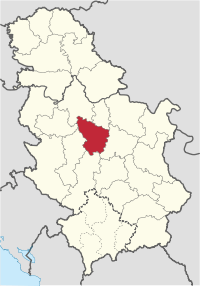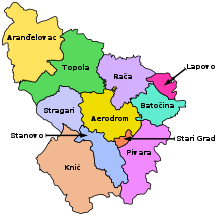Šumadija District
| Šumadija District Шумадијски округ Šumadijski okrug | |
|---|---|
| District of Serbia | |
 Location of the Šumadija District within Serbia | |
| Country |
|
| Region | Šumadija and Western Serbia |
| Administrative center | Kragujevac |
| Government | |
| • Commissioner | Biljana Ilić Stošić |
| Area | |
| • Total | 2,387 km2 (922 sq mi) |
| Population (2011 census) | |
| • Total | 293,308 |
| • Density | 122.9/km2 (318/sq mi) |
| ISO 3166 code | RS-12 |
| Municipalities | 6 and 1 city |
| Settlements | 174 |
| - Cities and towns | 5 |
| - Villages | 169 |
| Website |
www |
The Šumadija District (Serbian: Шумадијски округ / Šumadijski okrug, pronounced [ʃumǎdijskiː ôkruːɡ]) is one of eight administrative districts of Šumadija and Western Serbia. It is located in the central parts of the country. According to the 2011 census results, it has a population of 293,308 inhabitants, and the administrative center is the city of Kragujevac. The district is named after the geographical region of Šumadija.
Municipalities

The Šumadija District is divided into 6 municipalities and the city of Kragujevac. The municipalities of the district are:
Demographics
| Historical population | ||
|---|---|---|
| Year | Pop. | ±% p.a. |
| 1948 | 216,533 | — |
| 1953 | 227,929 | +1.03% |
| 1961 | 241,047 | +0.70% |
| 1971 | 264,344 | +0.93% |
| 1981 | 301,354 | +1.32% |
| 1991 | 312,160 | +0.35% |
| 2002 | 298,778 | −0.40% |
| 2011 | 293,308 | −0.21% |
| Source: [1] | ||
According to the last official census done in 2011, the Šumadija District had 293,308 inhabitants. 64.9% of the population lived in urban areas. The ethnic composition of the district:[2]
| Ethnic group | Population |
|---|---|
| Serbs | 282,772 |
| Romani | 2,095 |
| Montenegrins | 927 |
| Macedonians | 421 |
| Croats | 281 |
| Yugoslavs | 266 |
| Muslims | 126 |
| Gorani | 103 |
| Others | 6,307 |
| Total | 293,308 |
Culture and history
In the vicinity of Kragujevac stand several medieval monasteries, including the Annunciation monastery Divostin from the thirteenth century; the St. Nicholas monastery, believed to have existed at the time of the Battle of Kosovo in 1389; and the Drača monastery from unknown times.
In 1833 the Kragujevac Grammar School, the first Serb-language grammar school south of the Sava and Danube rivers, was founded in Kragujevac. Over the last fifty years this city of Serbian schooling has borne a symbol of grief: in the Memorial Park in Šumarice stands a monument to the pupils and teachers of this grammar school who were executed in World War II. Seeking to set a frightening example for all Serbia, German fascists executed 7,000 citizens in Kragujevac over the course of a single day, October 21, 1941. Among them were about 300 pupils and 18 teachers, including 15 boys from the ages of 8 to 15.
Economy
Today Kragujevac is a modern industrial center of Serbia. The most famous business is the Zastava car factory, now part of FIAT, which produced the famous Yugo automobile. Also prominent are the "21 Oktobar" factory which produces spare car parts, and the Zastava Arms firearms manufacturer.
See also
References
- ↑ "2011 Census of Population, Households and Dwellings in the Republic of Serbia" (PDF). stat.gov.rs. Statistical Office of the Republic of Serbia. Retrieved 11 January 2017.
- ↑ "Попис становништва, домаћинстава и станова 2011. у Републици Србији" (PDF). stat.gov.rs. Republički zavod za statistiku. Retrieved 15 December 2016.
Note: All official material made by Government of Serbia is public by law. Information was taken from {{url|https://web.archive.org/web/20090221052324/http://www.srbija.gov.rs/%7D%7D.
External links
| Wikimedia Commons has media related to Šumadija District. |
- Шумадијски управни округ (Serbian)